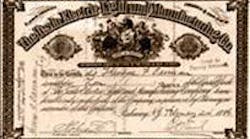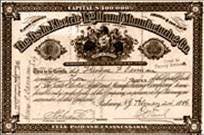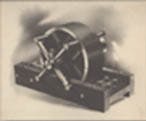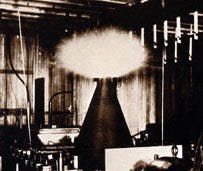By most accounts, the first electric lamp was developed by Sir Humphry Davy, a British chemist and inventor at the Royal Institution in London about 1809. Davy demonstrated the generation of an electric arc using two charcoal sticks and a 2,000-cell battery. Davy's experiment demonstrated that a discharge created between two electrodes in open air formed the shape of an arch. Heating of the air by the arc caused convection currents to develop, thus lifting the arc. Davy’s experiment coined the term "arch lamp," which is why we refer to discharge-type light sources as "arc lamps" today.
Given the great work of Thomas Alva Edison and the attention he received from his invention of the incandescent lamp in 1875 and 1876, most people are not aware that the invention of the electric light bulb actually started with two Canadian gentlemen — Henry Woodward and Mathew Evans. As residents in Toronto, Woodward was a medical student, and Evans was a hotel keeper. Together, they filed a Canadian patent application on July 24, 1874, directly followed by submission of a U.S. patent. Their invention consisted of a single glass tube containing a large piece of carbon filament with a wire connected to the filament protruding from each end of the tube. Filled with nitrogen to reach a longer filament burn time, the light bulb was effective at generating light and showed much promise. They received their Canadian patent on August 3, 1874, and sold it to Edison for $5,000.
With full rights to this most promising technology, Edison was conducting his own original investigations when he purchased the Woodward-Evans patent. Based on their work, Edison developed his own incandescent lamp design using a high-resistance thin filament of carbon in a high vacuum established by a tightly sealed glass envelope. The lamp had a service life that was satisfactory and practical for commercial applications.
It is interesting to note here that the work of Davy, which demonstrated that electrical energy could be used to generate light, was based on the generation of an electric arc, or discharge — which many years later and still today is called a plasma. The first electric light source was not based on the excitation of a filament wire, as was shown by the Woodward-Evans team in 1874 and shortly thereafter by Edison.
Although Edison's experiments initiated the first viable electric lamp, it opened the technology development channel in the late 1800s for a long line of inventions, fostering the development of discharge-type artificial light sources. Careful study of how alternating currents (AC) at high frequency led a brilliant Canadian scientist, Nikola Tesla (1856-1943) to demonstrate how AC power could be transferred to the inside of a sealed glass vessel without the use of wires or electrodes impregnating the vessel. This article provides an overview of some key highlights of Tesla’s work on high-frequency alternating currents and how his application of this phenomena paved the way for induction lighting.
Tesla’s work on induction and induction lamps
Nikola Tesla was a father of many inventions and discoveries in electricity and magnetism. He had a passion for understanding these physical phenomena, which later established the basis for thousands of experiments, patents, and technologies. Tesla's passion not only took the results of the scientific work from many of his predecessors and colleagues in his own time and advanced them, but it also provided the stem to many new inventions and discoveries based on electricity and magnetism following his death in 1943.
Tesla's desire to understand the physics of how energy could be transferred from one media to another without the use of a wire or electrodes drove him to invent the first induction lamp. Many of his technical writings were very informative in laying out his past accomplishments and provided countless critical details describing upcoming challenges other scientists would soon face. Tesla’s writings were also inspirational to other scientists who carefully studied electricity and magnetism. Without Tesla's attention to detail and passion to see theories mature to advance the understanding and application of electricity and magnetism, one can honestly say that hundreds of other experiments would have been delayed by decades or possibly may have never occurred at all.
Tesla published a paper entitled, "Experiments with Alternate Currents of Very High Frequency and Their Application to Methods of Artificial Illumination," which he delivered before the American Institute of Electrical Engineers [now called the Institute of Electrical and Electronics Engineers (IEEE)] in Columbia College on May 20, 1891 in New York. Tesla presented some key accomplishments that laid the framework to understand and advance inductive power transfer. This framework, along with careful documentation of the key challenges that needed to be studied and resolved, motivated other scientists to design, build, and use many more induction-based experiments. These experiments demonstrated the potential benefits of induction lighting, aiming this promising technology to become the first wireless artificial sources of illumination. This article quotes some of Tesla's findings as well as his challenges and provides a discussion on their relative importance to the continued growth of induction lighting.
Reading Tesla's article demonstrates that Tesla not only had a passion for electricity and magnetism but also a passion for inductive power transfer and the generation of light. He quotes in his second paragraph, "Phenomena upon which we used to look as wonders baffling explanation, we now see in a different light. The spark of an induction coil, the flow of an incandescent lamp, the manifestations of the mechanical forces of currents and magnets are no longer beyond our grasp; instead of the incomprehensible, as before, their observation suggests now in our minds a simple mechanism, and although as to its precise nature all is still conjecture, yet we know that the truth cannot be much longer hidden, and instinctively we feel that the understanding is dawning upon us. We still admire these beautiful phenomena, these strange forces, but we are helpless no longer; we can in a certain measure explain them, account for them, and we are hopeful of finally succeeding in unraveling the mystery which surrounds them." It is obvious that Tesla visualizes and believes that light can be generated by means of induction is well with reach of his time through the application of forces initiated by electric currents.
One of Tesla's key philosophies kept him attuned to the importance of understanding the theory behind electricity and magnetism. He quotes, "The old theory of Franklin, though falling short in some respects; is, from a certain point of view, after all, the most plausible one. Still, in spite of this, the theory of the two electricities [AC and DC] is generally accepted, as it apparently explains electric phenomena in a more satisfactory manner. But a theory which better explains the facts is not necessarily true. Ingenious minds will invent theories to suit observation, and almost every independent thinker has his own views on the subject." Tesla, being a scientist who focused significantly with a strong belief in alternating current (AC) was not rejecting the fact that two electricities existed in nature. Tesla believed a theory that better explained observable facts might not be the complete theory in attempting to explain why any phenomena occurred. In fact, induction lighting later became one of those phenomena that fit this exact philosophy.
While Tesla believed and understood that the phenomena of electric currents when steady (as in DC) behaved quite differently when they rapidly varied (as in AC), he recognized the importance of why the physical laws describing how alternating currents behaved differently as opposed to the laws of direct current. He quotes, "Of all these phenomena the most important to study are the current phenomena, on account of the already extensive and evergrowing use of currents for industrial purposes. It is now a century since the first practical source of current was produced, and, ever since, the phenomena which accompany the flow of currents have been diligently studied, and through the untiring efforts of scientific men the simple laws which govern them have been discovered. But these laws are found to hold good only when the currents are of a steady character. When the currents are rapidly varying in strength, quite different phenomena, often unexpected, present themselves, and quite different laws hold good, which even now have not been determined as fully as is desirable, though through the work, principally, of English scientists, enough knowledge has been gained on the subject to enable us to treat simple cases which now present themselves in daily practice." Tesla's recognition and belief that different phenomena occur and different laws hold good when alternating currents occur with rapidly changing strengths was vital to the success of inductive power transfer. Tesla knew that the responses that were observed in the alternating currents were the most important to study.
Tesla knew that in order to demonstrate that power could be transferred without the use of a wire or electrode, he had to generate a rapidly changing alternating current source — one that could be connected to a glass vacuum vessel capable of generating artificial illumination that could be visually observed. He quotes, "The phenomena which are peculiar to the changing character of the currents are greatly exalted when the rate of change is increased, hence the study of these currents is considerably facilitated by the employment of properly constructed apparatus. It was with this and other objects in view that I constructed alternate current machines capable of giving more than two million reversals of current per minute [or 33,333 Hertz], and to this circumstance it is principally due, that I am able to bring to your attention some of the results thus far reached; which I hope will prove to be a step in advance on account of their direct bearing upon one of the most important problems, namely, the production of a practical and efficient source of light." Tesla recognized that what appeared to be strange observations when generating discharges in open air provided more detail when higher frequencies were used. He built an alternating current machine capable of generating alternating current at 33,333 Hertz (or 33.3 kHz). He concluded that the development of this machine and its use in future experiments will advance one of the most important problems at that time — "…the production of a practical and efficient source of light." It is quite remarkable that Tesla recognized the importance of needing an efficient light source in the 1890s when efficiency would not be a global concern for about another 100 years.
Tesla also recognized that the coil in an induction circuit had to be small and contain lengths of wire that were short if it were to be suitable for excessively high frequencies. However, if the coil were not a good insulator, it might not be well adapted for high frequencies or adapted to support enormous differences of potential throughout the windings. Thus, Tesla determined that coils that were shellacked would be ideal for induction circuits — a design characteristic that is found in induction lighting products today.
Tesla worked extensively with spheres and spherical surfaces while studying discharges and induction circuits. He quotes "…streams seemingly pass with the greatest freedom through considerable thicknesses of insulators, and it is particularly interesting to study their behavior. For this purpose it is convenient to connect to the terminals of the coil two metallic spheres which may be placed at any desired distance. Spheres arc [better] preferable to plates, as the discharge can be better observed. By inserting dielectric bodies between the spheres, beautiful discharge phenomena may be observed. If the spheres be quite close and the spark be playing between them, by interposing a thin plate of ebonite between the spheres the span instantly ceases and the discharge spreads; into an intensely luminous circle several inches in diameter, provided the spheres are sufficiently large. The passage of the streams heats, and; after a while, softens the rubber so much that two plates may be made to stick together in this manner. If the spheres are so far apart that no spark occurs, even if they are far beyond the striking distance, by inserting a thick plate of mass the discharge is instantly induced to pass from the spheres to the glass is the form of luminous streams. It appears almost as though these streams pass through the dielectric. In reality this is not the case, as the streams are due to the molecules of the air which are violently agitated in the space between the oppositely charged surfaces of the spheres. When no dielectric other than air is present, the bombardment goes on, but is too weak to be visible; by inserting, a dielectric the inductive effect is much increased, and besides, the projected air molecules find an obstacle and the bombardment becomes so intense that the streams become luminous. If by any mechanical means we could [affect] such a violent agitation of the molecules we could produce the same phenomenon. A jet of air escaping through a small hole under enormous pressure and striking against an insulating substance, such as glass, may be luminous in the dark, and it might be possible to produce a phosphorescence of the gloss or other insulators in this manner." From this, we can see that Tesla recognizes the critical nature of the dielectric and how it affects control of the discharge as well as how the alternating energy heats the dielectric — two phenomena that have proven to be critical to the performance and success of induction light sources today. Moreover, Tesla describes how energetic molecules after bombardment can be directed toward an insulating surface that might be used to excite a phosphorescent coating, which is how fluorescent and induction lamps produce light today.
Tesla unraveled the details describing the importance of the inductive capacity of a dielectric in an induction circuit. This determines how energy must flow in an induction circuit in order to preserve the integrity of the dielectric and to start and sustain a discharge. Tesla quotes, "The greater the specific inductive capacity of the interposed dielectric, the more powerful the effect produced. Owing to this, the streams show themselves with excessively high potentials even if the glass be as much as one and one-half to two inches thick. But besides the heating due to bombardment, some heating goes on undoubtedly in the dielectric, being apparently greater in glass than in ebonite. I attribute this to the greater specific inductive capacity of the glass; in consequence of which, with the same potential difference, a greater amount of energy is taken up in it than in rubber." Tesla’s comment on "…the more powerful the effect produced " demonstrates his understanding of what was needed to ensure proper energy transfer into the discharge rather than wasting energy heating up the dielectric. Tesla's understanding of dielectrics used in inductive circuits allowed modern scientists and engineers to refine induction lighting technologies used today.
Conclusion
It's obvious from a review of some of Tesla's work that he clearly understood the importance of inductive power transfer for a number of applications, especially lighting. Tesla's fascination with the illumination produced by discharges — in the form of ionized clouds of gas or in the form of streamers inside a vacuumed vessel — kept his interest in induction energized. Although he profited very little from his long tenure as a scientist, his work sparked new and continued interest in many scientists that followed his footsteps. Tesla's demonstration of the first "wireless light" in one of his lectures given at Columbia College in New York spawned interest in induction lighting that continued throughout the 19th and 20th centuries. Today, Nikola Tesla is still known as the father of induction lighting — a lighting technology that is regaining momentum in our energy-strained world.
Keebler is a principal engineer and partner at KCE Engineering, LLC located in Knoxville, Tenn. He is an 18-year veteran of the Electric Power Research Institute (EPRI) in the Energy Utilization Group of the Power Delivery & Utilization sector. His work at EPRI also involved the development of new standards for ANSI, IEEE, IEC, NEMA, IESNA and CISPR as well as product standards for lighting, building PQ and EMC, including EMC standards on EMI filters; energy-efficiency and PQ standards for CFLs, HID, LED, and MIL. He can be reached at [email protected]. Check out his Power Quality Perspectives blog exclusively on www.ecmweb.com.
Evans is VP technical services with KCE Engineering, LLC. He can be reached at [email protected].
Reid is laboratory manager with KCE Engineering, LLC. He can be reached at [email protected].






